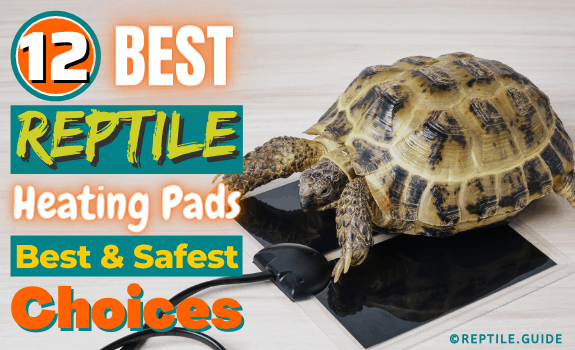When you install it according to the manufacturer’s instructions, a heating pad is one of the safest heating options for your pet reptile’s home.
Since the heat pad only produces heat in a specific area, it also helps to create a temperature gradient.
You want a temperature gradient for your pet, since it allows them to choose the level of warmth that suits them best at that moment.
Choosing the right reptile heating mat may seem daunting, but it’s straightforward. Join us as we learn more about the best reptile heating pad options.
Curious or in a hurry?
✅Buyer’s Tip: This reptile tank heating pads are large enough to heat up 50-60 gallon terrariums. We also highly recommend this heating pad for snakes and other reptiles since it is available in multiple sizes.
In This Article
In Short
- A heat mat operates as an external heat source, warming a specific part of your pet’s terrarium.
- It’s safe to use a seedling heat mat for your pet, as long as it has a thermostat or doesn’t reach extreme temperatures.
- The best heating pads for reptiles have a built-in thermometer and temperature controller.
- Never attach a heat pad to the whole bottom of your pet’s terrarium.
How to Use a Reptile Heating Pad
The best reptile heating pads are simple pieces of equipment that don’t take a lot of thought.
For best results, set up the heating pad BEFORE filling the enclosure with substrate and adding your pet.
You need to find the place where your heat pad will be most effective in creating a “hotspot” for your pet.
Since most reptiles require the combination of a heat source and UV bulb, the best reptile heat pad location is below the bulb.
This configuration allows the reptile to absorb heat while absorbing ultraviolet rays.
Other setups may lead to your pet using either the heat mat or the bulb instead of both.
Let’s run through how to use heating mats step-by-step.
- When you’ve determined where to place the heating pad, remove the cover from the adhesive side of the pad.
- Stick the heat mat to the bottom of the tank—it should cover no more than one-half of the tank’s underside.
- Turn the tank right-side up, and add substrate.
Top Tip: Since a reptile heat pad is external, you should use no more than an inch of substrate. Using more than that may compromise the efficiency of the heating pad.
- If the product you chose came with a temperature probe, insert that into the substrate above the heat pad.
Expert Tip: When you use a thermostat with your reptile heating pad, you need to ensure that the temperature probe is above the heating pad.
- If the probe is too far from the heating pad, the thermostat will get the signal that the heat mat is cold and keep trying to push up the temperature. This type of error can have a lethal result.
- If your reptile heat mat came with a thermostat, or you bought one, set it to the appropriate temperature for your pet reptile.
- Use an independent thermometer, which you know is accurate, to measure the temperature above the heat mat.
- Check the thermometer every 30 minutes for three hours. If the temperature stays within the desired range, you can go ahead and finish setting up the habitat.
Reptile Heating Pad With Thermostat – iPower Reptile Heat Pad with a Digital Thermostat
The iPower Terrarium Reptile Heating Pad with a Digital Thermostat is an ideal reptile heating pad for small animals.
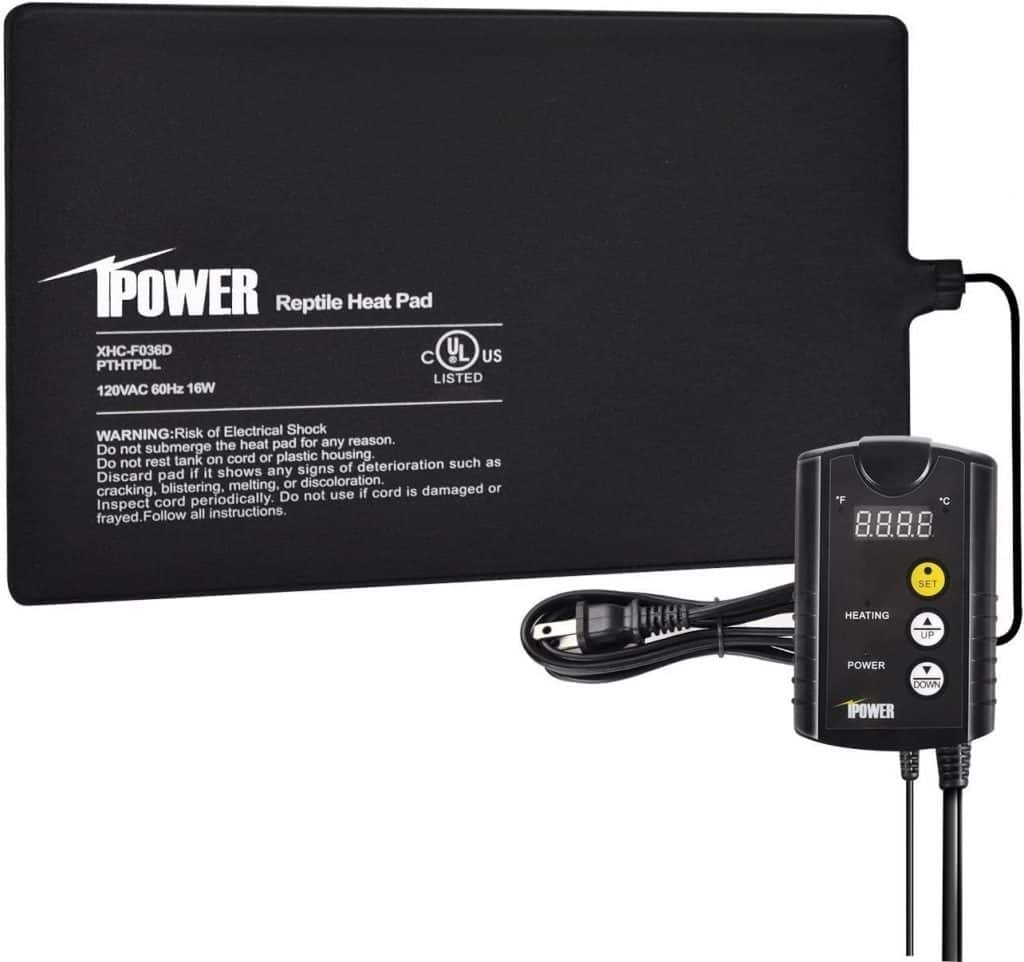
The standard size is 8 x 12 inches, but it’s available in different sizes. Other options include:
- 8 x 18 inches
- 6 x 8 inches
- 4 x 7 inches
Thanks to this company’s collaboration with 3M glue, you can rest assured that the adhesive side of this heat mat will keep it where you put it.
The iPower Reptile Heat Pad comes with a simple plug-and-play thermostat, and the two click together with minimal effort.
This heating mat provides a source of heat that can maintain temperatures of between 40°F and 108°F.
The iPower Reptile Heat Pad is one of the best reptile heating pads if you want simplicity combined with effective control over the temperatures in question.
It’s worth noting that this pad is waterproof, so you don’t need to worry about minor spills or condensation around your reptile habitat.
Check Price and Reviews on AmazonHeating Pad for Reptile Tank – Zilla Reptile Terrarium Heat Mats
The Zilla brand creates some of the best reptile heating pads for no-frill installation.
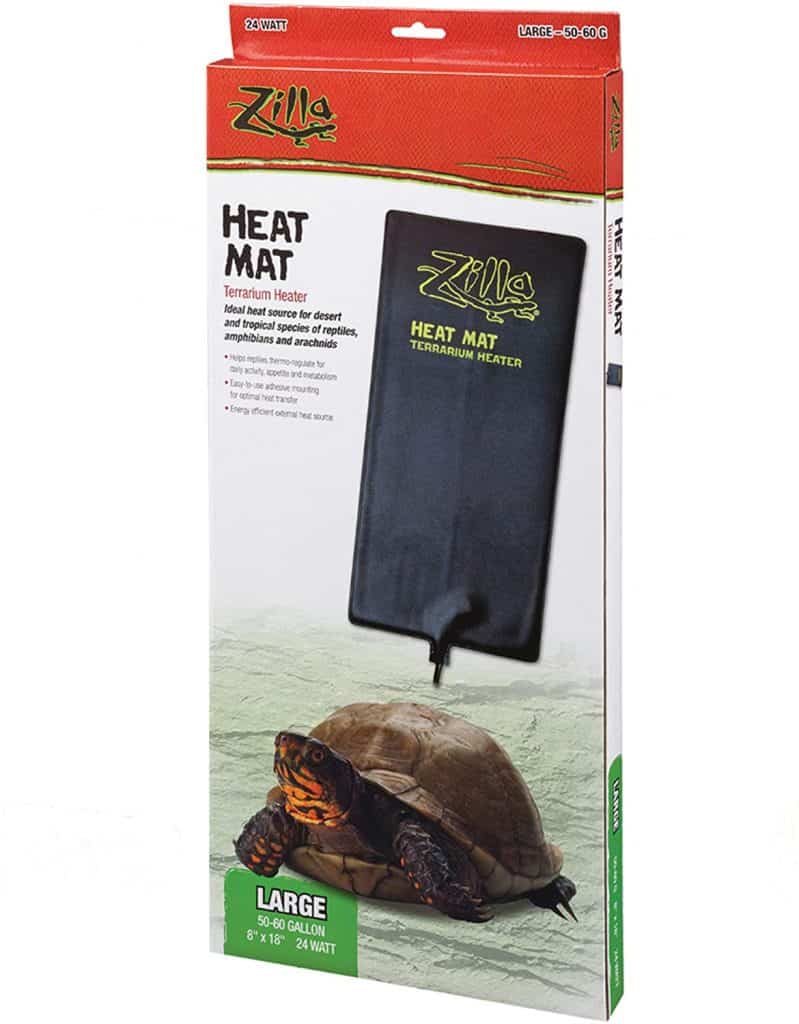
Zilla reptile heating pads come in several different sizes.
You can buy:
- The mini, which is 4 x 7 inches
- The small, which is 6 x 8 inches
- The medium, which is 8 x 12 inches
- The large, which is 8 x 18 inches
This heat mat is self-regulating and can reach temperatures of around 113°F.
According to the manufacturer, once you’ve attached the tank heater to the glass of your pet’s enclosure, the substrate and glass create a buffer.
As a result of the buffer, this heat source will only raise the substrate temperature by around 10 to 15 degrees—perfect for your reptile or other small animals.
This Zilla heat mat is ideal for a 50 to 60-gallon tank and is easy to attach thanks to its ready-to-stick adhesive backing.
Check Price and Reviews on AmazonLarge Reptile Heating Pad – Blue Spotted Under Tank Heater
The Blue Spotted self-adhesive heaters for glass terrariums are a hassle-free and efficient way to keep your reptiles warm.
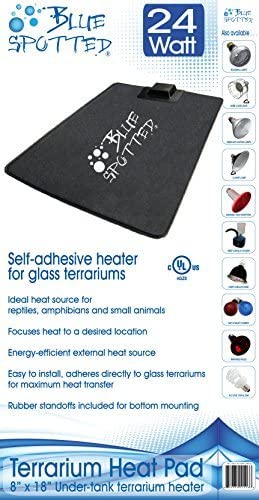
This heating mad is large, coming in at 8 x 18 inches, and runs on 24 watts of power. Whether your obsession is snakes or giant geckos, this heater has you covered.
Blue Spotted self-adhesive heaters are general plug-and-play devices that don’t require a thermostat to work.
If you’re looking for a simple heater to warm your large reptile tank, you can’t get any more straightforward.
As with most devices without a temperature controller, you can expect it to reach temperatures of up to 108°F.
This heating mat is ideal as a secondary heat source, along with a heat lamp or basking lamp.
Check Price and Reviews on AmazonLarge Reptile Heating Mat With Thermometer – Zoo Med Laboratories SZMRH20 Habitat Heater
Zoo Med laboratories are renowned for their products for reptiles and amphibians.
Whether you’re looking for a terrarium, a thermostat, or a heat mat, this brand has you covered.
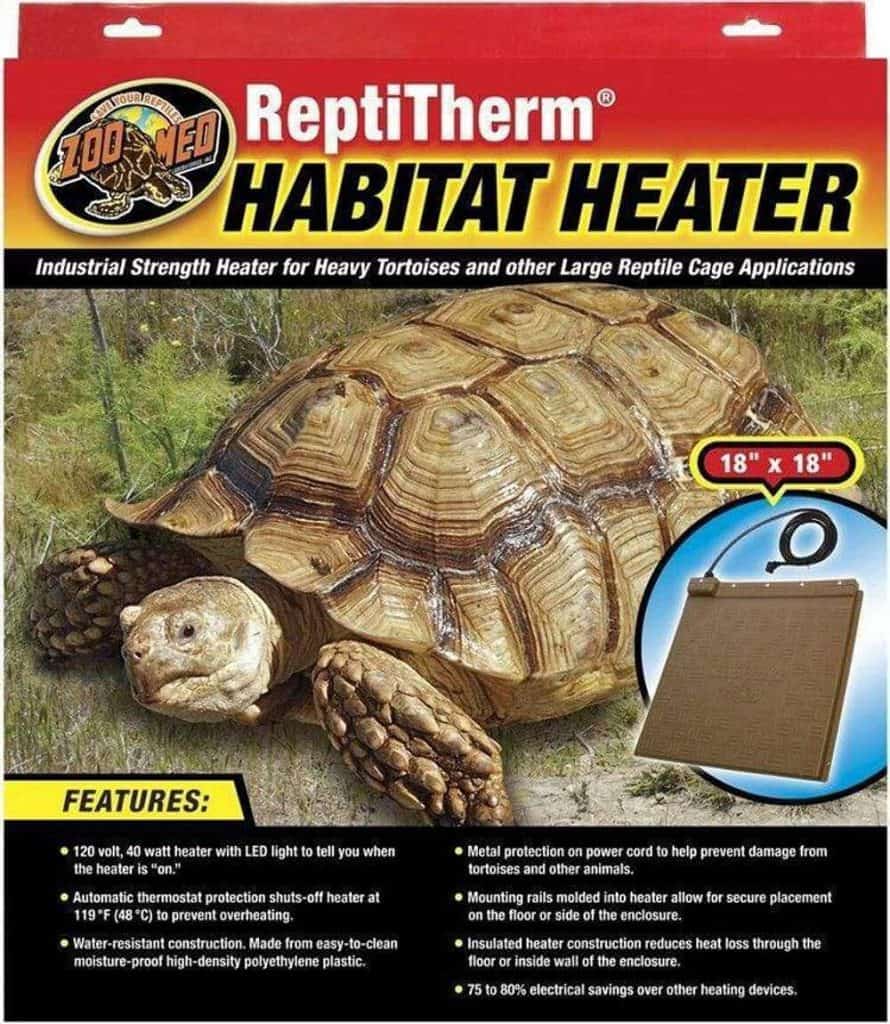
The Zoo Med Laboratories SZMRH20 Habitat Heater is ideal if you need to cover a larger area.
At 18 x 18 inches, this device is excellent for setting up tanks for larger species of reptiles.
You can use it with or without a thermostat, though a temperature controller will give you the best results.
Without an external thermostat, these heaters cut off at 119°F to protect your pet.
While you can use this on the outside of a large tank, the design facilitates use INSIDE the enclosure of large reptiles.
Many hobbyists use these heaters for giant tortoises like Sulcata or Leopard Tortoises. The power cable has metal covers so that large reptiles won’t damage it.
As with most products from this brand, this heating pad is easy to clean, though you’d be wise not to get it too wet.
The Zoo Med Laboratories SZMRH20 Habitat Heater is a waterproof, 40-watt heating pad that comes with a limited one-year warranty.
Check Price and Reviews on AmazonReptile Heat Mat with Temperature Control – Zacro Reptile Heat Pad with Thermostat
If you’re looking for a simple, efficient tank heater that won’t make you feel like you need to sell a kidney to pay for it, then Zacro is the brand for you.
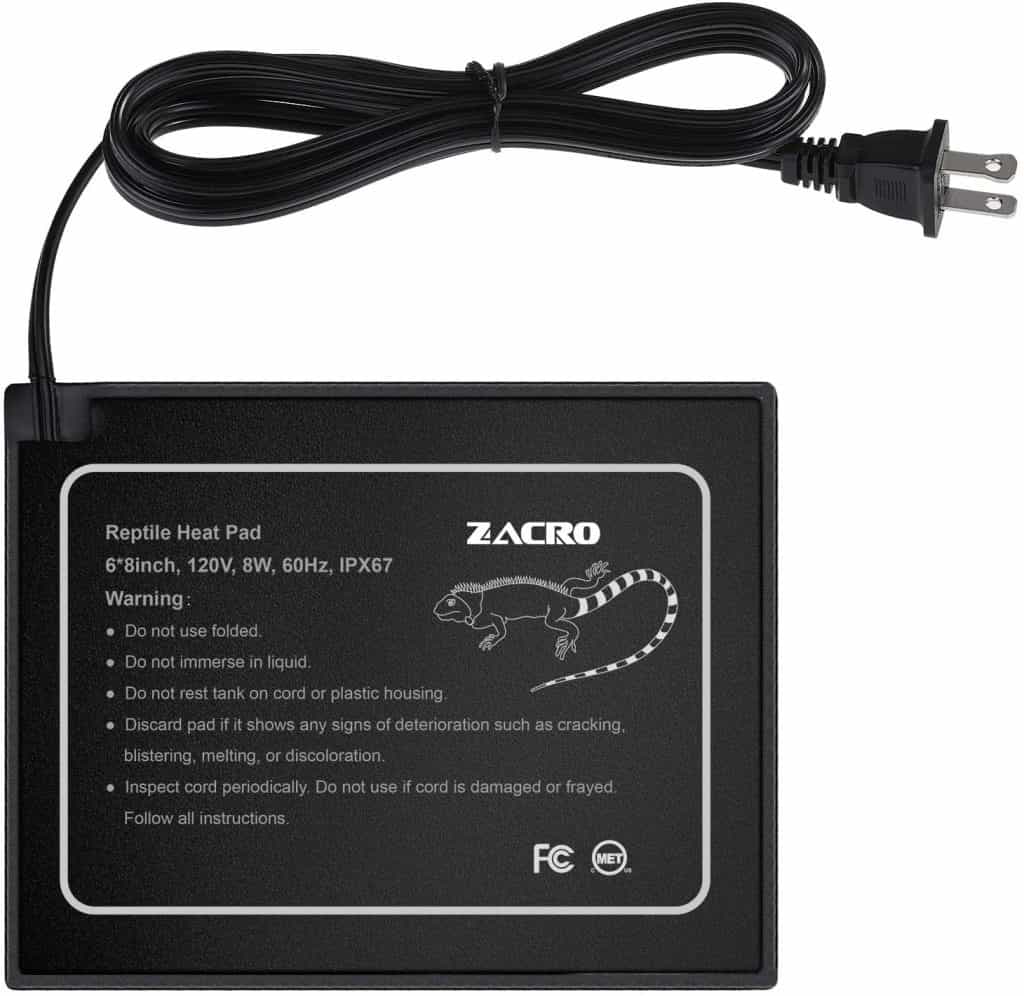
This 12 x 18-inch reptile heating pad has a 5.9-foot cord and a waterproof surface.
Pro Tip: Even if you buy a waterproof heating mat or reptile tank heater, NEVER IMMERSE IT IN WATER. The coating can handle spills and condensation, not submersion.
The low-wattage (8 watts) Zacro Reptile Heat Pad with Thermostat is a simple plug-and-play system. Use the included 3M adhesive to stick it to the reptile tank, and it’s ready to go.
The recommended use for this product is to heat tanks between 10 and 20 gallons in size.
Check Price and Reviews on AmazonBest Budget Reptile Tank Heater – Giveme5 Upgrade US Plug 110V Reptile Heating Pad
For many hobbyists, pricing is as important as safety and quality. Giveme5 makes one of the best budget-friendly tank heaters.
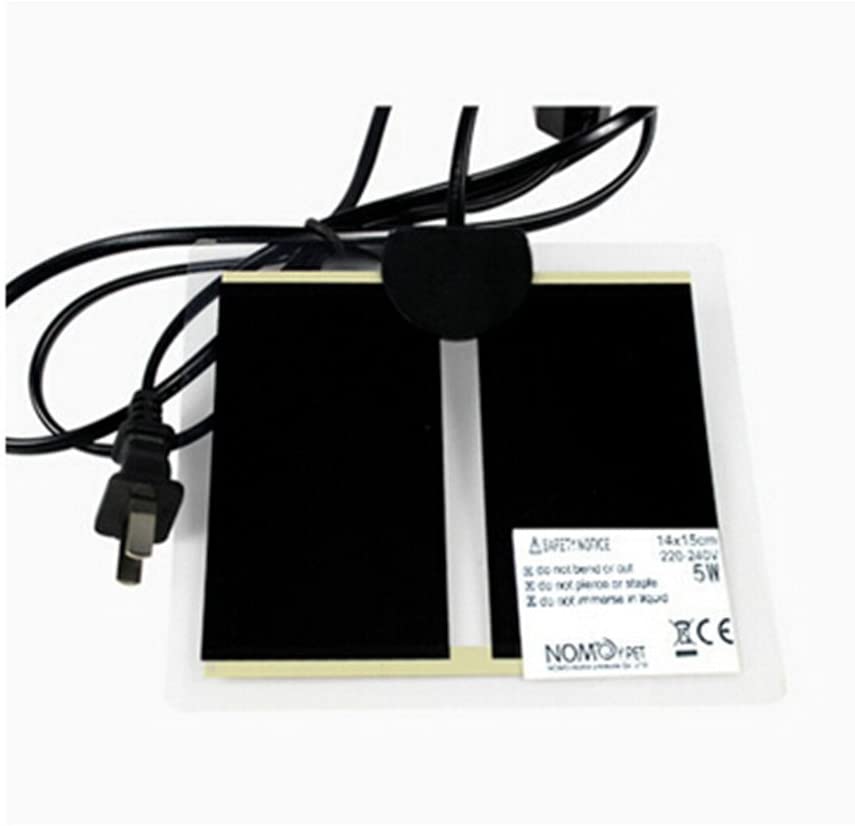
This durable silicone heat mat comes in multiple sizes and wattage options:
- 5 x 5 inches – 5 watts
- 5.9 x 11 inches – 7 watts
- 11 x 11 inches – 14 watts
- 16.5 x 11 inches – 20 watts
Thanks to their thrifty design, these heat mats are mostly waterproof and don’t require digital thermostats.
They don’t come with adhesive, so you’ll need to use double-sided tape or something similar to stick the mat to the tank.
Once the Giveme5 Heating Pad is attached to the terrarium, all you need to do is set the temperature controller dial and wait for the device to heat up.
Check Price and Reviews on AmazonBest Reptile Under Tank Heating Pad – Fluker’s 29050 Heat Mat
Fluker’s is a brand with a reputation for durability and one of the most recommended heating mat suppliers on the internet.
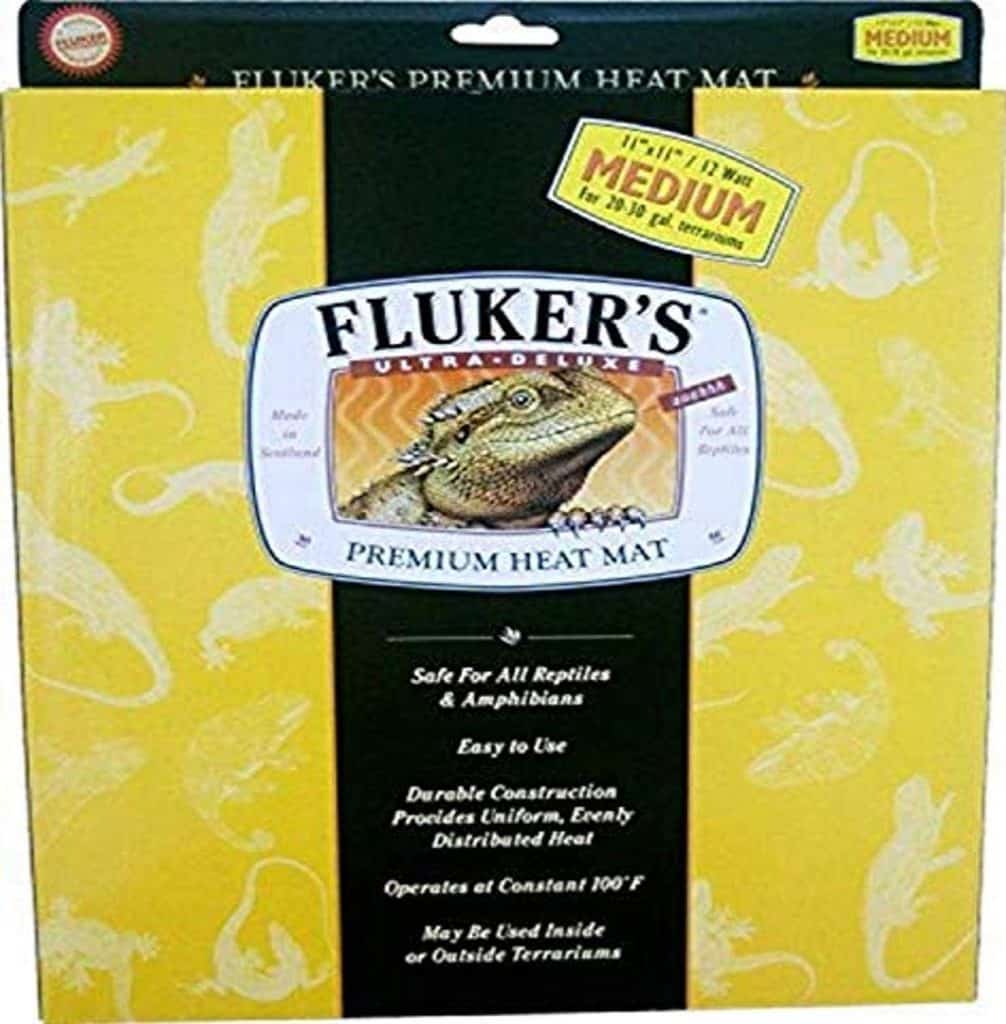
The Fluker’s 29050 is simplicity personified—If you’re looking for a plug-and-play device that won’t get too hot for your animals, this is it.
While you CAN use this heater with a thermostat, you can rest assured that it WON’T overheat your pet’s terrarium if you don’t.
The Fluker’s 29050 maintains a consistent temperature of 100°F when used as a plug-and-play device.
These heaters come in multiple sizes, and you can buy:
- 4 x 5 inches
- 6 x 11 inches
- 11 x 11 inches
- 17 x 11 inches
- 29 x 11 inches
With their low wattage (between 7 and 35 watts) and ease of use, Fluker’s 29050 heat mats are ideal for new keepers or those who like low-hassle devices.
Check Price and Reviews on AmazonBest Heating Pad for Snakes – iPower Reptile Heat Pad Under Tank Terrarium Warmer
If you’re looking for a heating mat for your pet snake, the iPower under tank heat pad is an excellent choice.
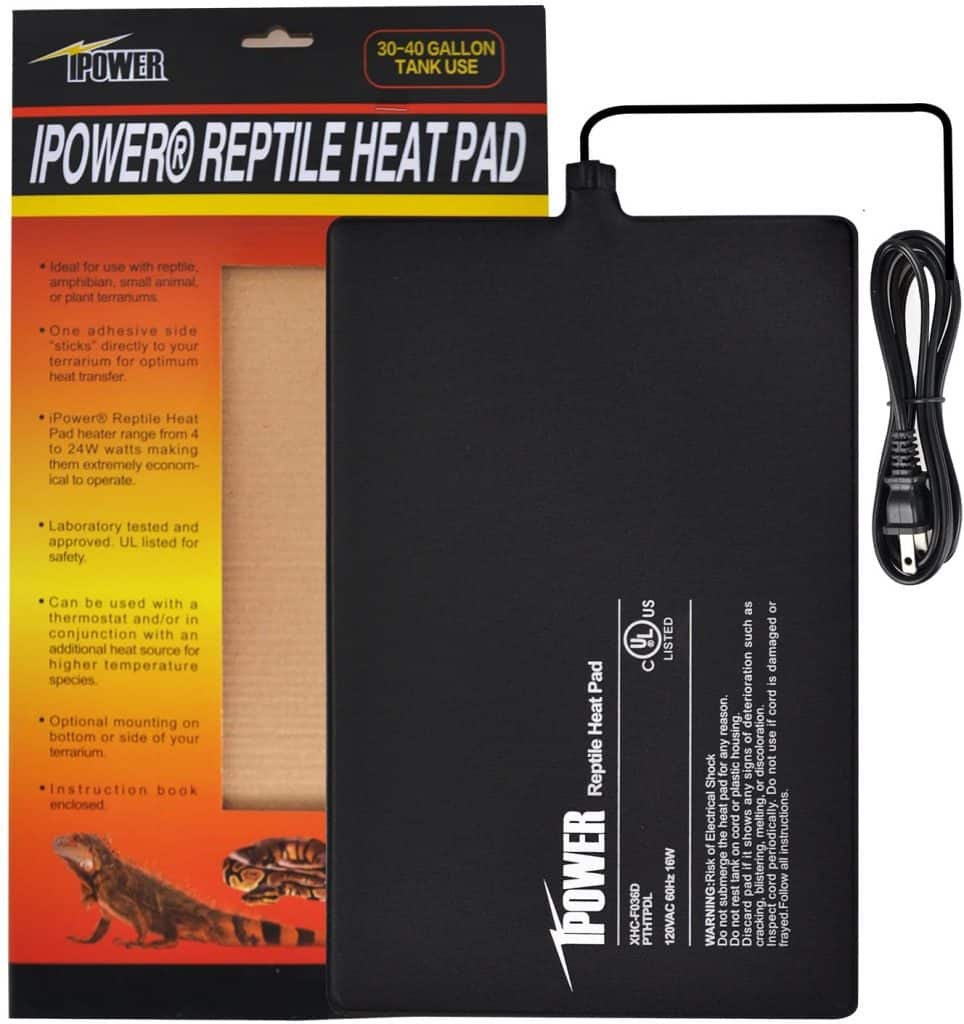
This external tank heater comes in different sizes to facilitate heating your enclosure, however large it may be.
The standard size is 8 x 12 inches, but you can also order:
- 4 x 7 inches
- 6 x 8 inches
- 8 x 18 inches
It’s also possible to buy an iPower combo deal that includes a thermostat.
As with other iPower heating mats, this model comes with a 3M adhesive to ensure that your heat mat is going nowhere fast.
Thanks to the six-foot-long power cable and waterproof design, it’s easy to find a place to put your pet reptile’s enclosure.
With a thermostat, the iPower under tank heat pad can reach temperatures of around 108°F.
Check Price and Reviews on AmazonBest Under Tank Heating Pad for Leopard Geckos – Aiicioo Under Tank Heater with Thermostat
The Aiicioo Under tank heater comes in several device sizes and wattage strengths.
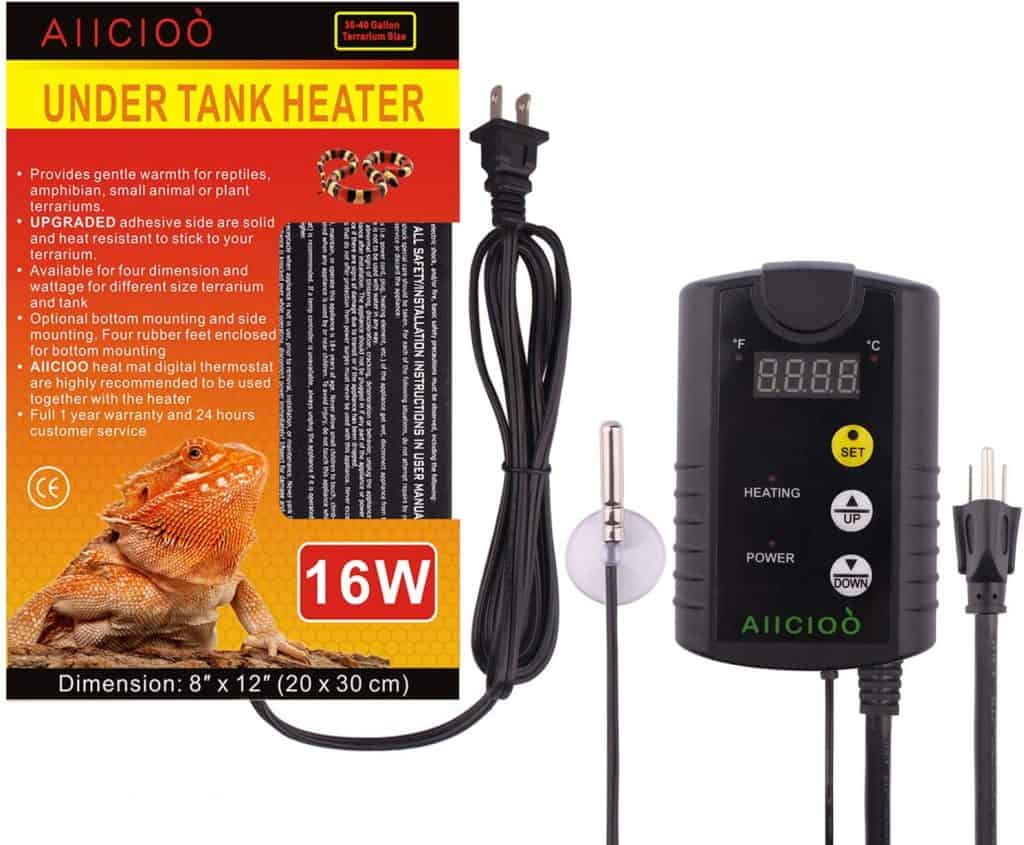
You can choose between:
- 8 watts
- 16 watts
- 24 watts
The corresponding mat sizes are:
- 8 x 6 inches
- 8 x 12 inches
- 18 x 8 inches
The thermostat that comes with this device will keep the heating mat in a temperature range of between 68°F and 108°F.
As with many of the other heaters on this list, the thermostat is a simple three-button device. It allows you to set the temperature and change between °F and °C.
This simplicity is ideal because you don’t want to feel like you’re performing brain surgery when you heat your pet’s home.
The thermostat is plug and play, so connecting to the heating pad is effortless.
The creators have dedicated one entire side of the Aiicioo Under Tank Heater to adhesive paper, so you just need to peel off the cover and stick it to the glass.
Check Price and Reviews on AmazonBest Digital Reptile Heating Pad – Tikaton Reptile Heat Pad
The Tikaton Reptile Heat Pad has much to recommend it.
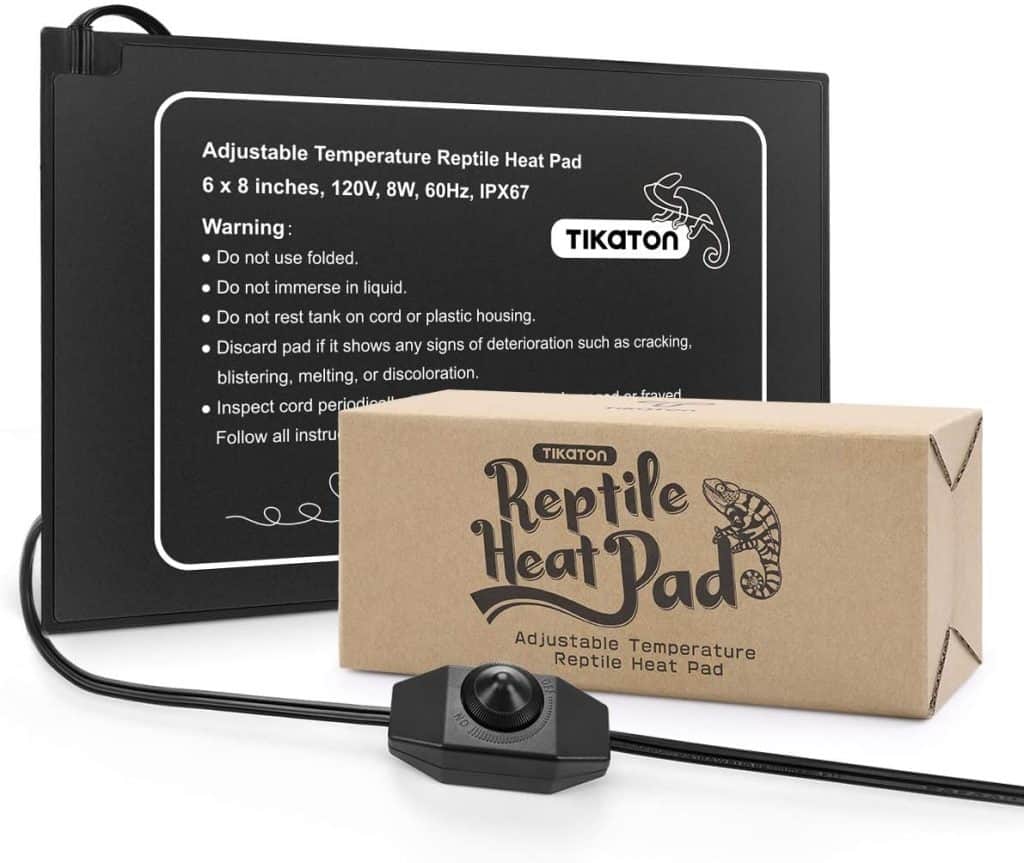
These mats have 3M adhesive to enable sticking the heater to the terrarium glass, which means it’s a simple job to keep your terrarium warm.
You can purchase any of these sizes:
- small (6 x 8 inches)
- medium (8 x 12 inches)
- large (18 x 8.5 inches) model
All the models use low wattage (8-24 watts), come with 5.9-foot long power cables, and have a flexible, waterproof PVC surface.
Instead of the traditional thermostat, these mats have a temperature control dial (much like a light dimmer switch).
Turn the knob to the appropriate temperature, and wait for the magic. The Tikaton Reptile Heat Pad can reach temperatures of around 140°F.
Check Price and Reviews on AmazonBest No-Hassle Reptile Heating Pad – Zoo Med ReptiTherm Under Tank Heater
These excellent heating mats for reptiles use low wattage (between four and 24 watts), making them economical on your power bill.
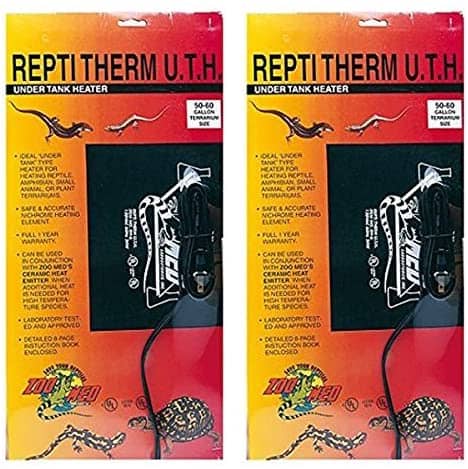
If you’re looking for no-hassle heat mats that give you the advantage of plug and play, this Zoo Med product is a perfect choice.
The Zoo Med ReptiTherm Under Tank Heater comes in packs of two and has a full adhesive pad, so you can just stick it to the glass of your terrarium.
Without a thermostat, Zoo Med claims that these heat mats will raise the temperature of the substrate in your tank by between two and eight degrees.
If you’re worried that your tank might get too hot, you can also use the Zoo Med ReptiTherm Under Tank Heater with a thermostat.
Check Price and Reviews on AmazonCan You Use a Seedling Heat Mat for Reptiles?
This question is one of the most common queries from hobbyists looking for their first heating mat.
The simple answer is yes, as long as it comes with a thermostat or doesn’t get too hot.
It should also be small enough to fit under a selected part of your pet’s enclosure. You don’t want a heating mat that will heat the entire bottom of the habitat.
We feel so confident about the safety of using seedling heat mats for heating your pet’s habitat that we’ll even make a recommendation.
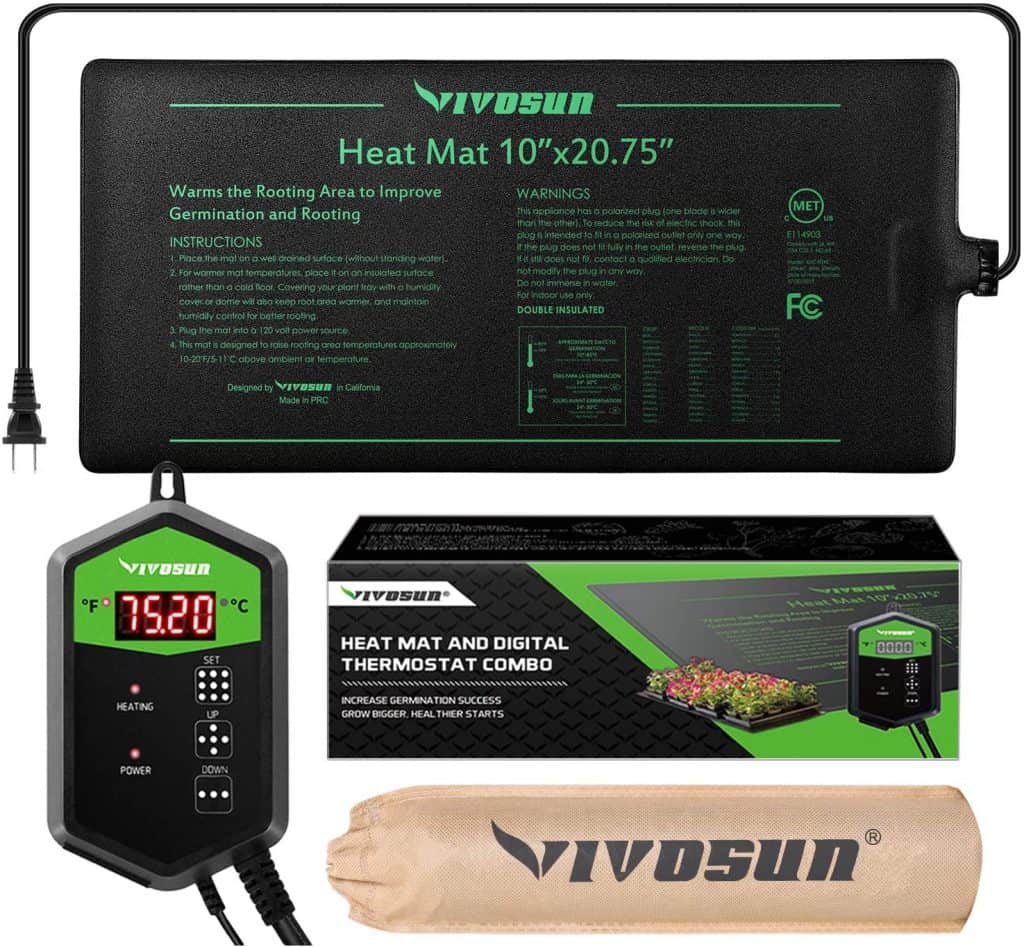
The VIVOSUN Seedling Heat Mat and Digital Thermostat is a regulatable system that provides all the heating your cold-blooded pet might need.
This system is large, at 10 x 20.75 inches, so it’s best to use it for larger enclosures.
This VIVOSUN Seedling Heat Mat and Digital Thermostat can maintain temperatures between 40°F and 108°F and comes with a simple yet efficient controller with three buttons.
You’ll use two of the buttons to set the controller to the appropriate temperature, and the third changes the display temperature between °F and °C.
Since the design of this VIVOSUN Seedling Heat Mat and Digital Thermostat focuses on seedlings rather than reptiles, it doesn’t come with an adhesive backing.
It is, however, entirely waterproof.
Are Reptile Heating Pads Safe?
If you follow the manufacturers’ directions, reptile heating pads are one of the safest and most efficient heating options.
This safety is the result of how you set up a reptile heating pad. Rather than placing the device in the tank with the animal, it sticks onto the bottom of the tank.
Since the heat source is external, there’s NO risk of the reptile accidentally burning by touching it.
When installed correctly, the heating pad also helps create a temperature gradient rather than heating the entire habitat.
Most basic reptile heating pads have a built-in cutoff switch that prevents the device from overheating the tank.
Not all heating pads for reptiles come with this function, and they may malfunction.
It’s always wise to use a thermostat with your device, which will keep the heater in the optimal temperature range.
As long as you DON’T install your heating pad inside your pet’s habitat or place it in contact with anything flammable, this is a convenient and safe heat source.
Top Tip: Manufacturers specifically design some reptile heating mats for use inside enclosures. Read the packaging carefully to determine whether your heat pad is an under-tank heater.
How Important Is It to Have a Separate Thermometer?
Whether you buy a complex system with a thermostat, or a simple plug-and-play heating mat, monitoring the temperature and humidity is essential.
We have an entire article about the best thermometers and hygrometers for your reptile enclosures. We suggest having a look at that before you buy a device for your pet’s tank.
Most of the more complex heating systems come with a relatively accurate thermometer probe, which allows the thermostat to determine whether the heat pad needs to get hotter or cool down.
The downside of relying solely on the thermostat’s temperature probe is that if the thermostat malfunctions, the thermometer may glitch as well.
Built-in thermostat probes generally don’t take humidity readings, so you won’t know if you’re drying out your reptile while trying to keep it warm.
We recommend buying a reliable and reputable reptile thermometer for your enclosure. It will help you keep track of the ambient temperature.
Your enclosure should also have at least one hygrometer (humidity meter) to help you manage the tank’s humidity.
You can also buy a device that acts as both a thermometer and hygrometer. These are ideal for keeping track of the general conditions in your terrarium.
In most cases, it’s a good idea to have a general thermometer to keep track of the ambient temperature and a dedicated thermometer located above the heating mat.
By keeping an eye on the dedicated thermometer, you’ll know exactly if and when your heat mat malfunctions and can handle it accordingly.
You might also want to check out our article about accessories for your reptile enclosure.
How Does the Substrate Affect My Under-Tank Heater?
Though you might not think so, the type of substrate that you use can have a significant impact on the temperature your heater reaches.
Before we discuss the substrates themselves, it’s worth noting that glass isn’t the best conductor of heat.
Glass is the product of superheated silica sand, so it keeps a few of its conductive properties, but it also has some minor insulating qualities in its finished form.
The result of this combination is that glass is more of a semi-conductor than anything else, and you’ll lose a fair bit of heat while trying to push the heat through the glass into the substrate itself.
Let’s get back to the substrates. Once the heat makes its way through the glass, it still needs to warm the substrate so your pet can benefit from it.
Different substrates have different reactions to heat. For example:
- Vermiculite and perlite both come from superheated processes. They’re insulators, but they’ll maintain heat for a while once they’re warm.
- Wood chips are an insulation material. Once they’re warm, they’ll maintain the temperature for a while, but they also offer plenty of initial resistance to heating up.
- Recycled paper, newspaper, and cardboard are all insulators. They resist heat, and they won’t maintain warmth for any length of time once the heating mat deactivates.
- Coco peat, peat, and sphagnum are all insulators. They react in much the same way as wood chips. They’re also involved in constant slow decomposition, so they may produce some minor heat.
- Sand is a conductor; it will absorb and redistribute heat. This property makes it a suitable substrate above heat mats but can also make it hard to gauge which temperature will reach your pet.
In short, the type of substrate you use has a significant impact on the temperature the tank ultimately reaches.
Using a combination of elements can either improve or worsen your substrate’s ability to get warm.
First, find the substrate that works for your pet, then add more heat or drop the heat to compensate for the substrate’s unique qualities.
We hope you’ve enjoyed this article about the best reptile heating pads for your reptiles and other cold-blooded animals.
If you’re busy setting up your first enclosure, check out our DIY plans for reptile enclosures.
You can also learn from our article about the best bearded dragon habitats and leopard gecko habitats.
As always, if you have any thoughts, comments, or suggestions, feel free to drop a comment below.
